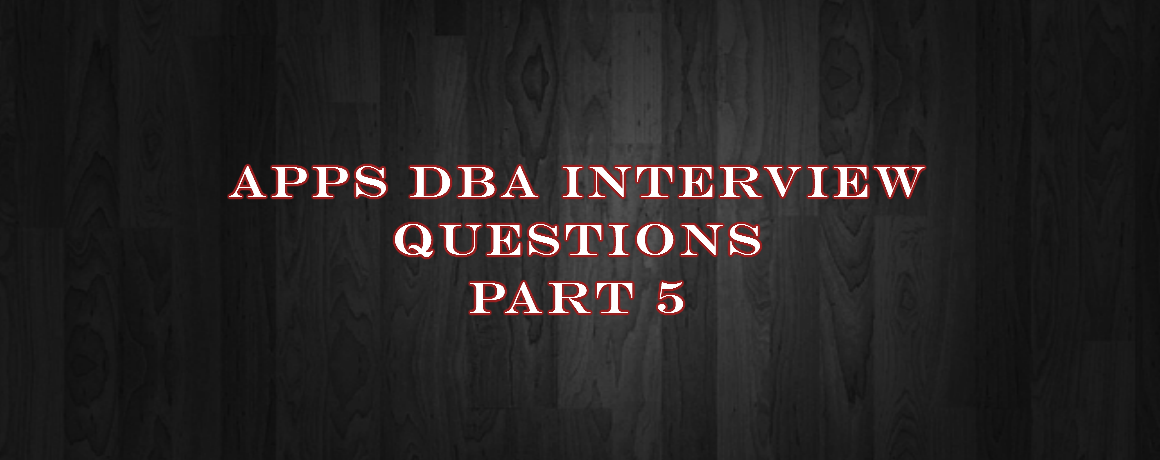Apps DBA Interview Questions Part 5

1.What is Online Patching?
Online patching is a new patching mechanism that is available with R12.2 that allows the application of patches while the system is up and running, and the users are working as normal.
2.Which Oracle E-Business Suite releases Online Patching feature is available?
Online patching is used with Oracle E-Business Suite 12.2 and higher.
3.What types of patch are applied online?
All Oracle E-Business Suite Release 12.2 patches are applied online. This includes one-off patches, patch rollups, consolidated updates and security patches.
4.What is the Online Patching cycle?
The Online Patching Cycle is a sequence of inter-related steps (phases) used to apply patches to an Oracle E-Business Suite system.
5.What tool is used to apply online patches?
The AD Online Patching (adop) command-line utility is used to manage the Online Patching cycle.adop invokes adpatch is the background only.
6.Is there any downtime in Online Patching?
There is a short period of downtime when the application tier services are shut down and restarted. The database remains open all the time.
7.Once I upgrade to Release 12.2, can I still apply patches in the traditional way?
No. All patches for Release 12.2 will be online patches. The traditional, pre-12.2 method of applying patches will not work.There are option like downtime and hotpatch which works more like traditional way but they are used for patches directed by Oracle
8.What is the Online Patching infrastructure?
This infrastructure includes database objects edition and patch/run file system components.
9.Does Online Patching require the 11gR2 Oracle Database feature?
Yes. Online patching depends on the Edition Based Redefinition (EBR) feature that was introduced in the Oracle 11gR2 Database. Most notably, EBR allows edition of code objects in the database. To do this, it provides new object types such as editions, edition views, and cross-edition triggers, all of which are part of the Online Patching infrastructure.
10.What are the phases that make up the Online Patching cycle?
The Online Patching cycle consists of the following phases:
a) Prepare a virtual copy (patch edition) of the running application (run edition).
b) Apply patches to the patch edition of the application.
c) Finalize the system in readiness for the cutover phase.
d) Cutover to the patch edition and make it the new run edition.
e) Cleanup obsolete definitions or data to recover space.
11.What downtime is required during an Online Patching cycle? or as the name spells online,there is no downtime in the whole process?
The cutover phase requires a short period of downtime (typically a few minutes) for transition tasks such as a restart of the application tier services.
12.Is any downtime required for the database tier?
No. In fact, the database needs to be up and running during each phase of the Online Patching cycle.
13.How does Online Patching work on the application tier?
During Release 12.2 installation, Rapid Install will lay down two copies of the application tier file system. One of the copies will be labeled as the run file system, and the other as the patch file system. Subsequently, when a patch is applied, adop will:
1.Synchronize the contents of the run file system to the patch file system. This happens during the prepare phase.
2.Perform patching actions on the patch file system. This happens during the apply phase.
3.Finally, during the cutover phase, the adop utility restarts the application tier services. The patch file system is then promoted to be the new run file system, and the old run file system becomes the patch file system for the next patching cycle.
[edsanimate_start entry_animation_type= “bounceIn” entry_delay= “0” entry_duration= “1.5” entry_timing= “linear” exit_animation_type= “” exit_delay= “” exit_duration= “” exit_timing= “” animation_repeat= “infinite” keep= “yes” animate_on= “load” scroll_offset= “” custom_css_class= “”]
Note that a third file system, the non-editioned file system (fs_ne), is created to store files containing data that is needed across all file systems,such as log files.
[edsanimate_end]
14.How do I apply Oracle Fusion Middle-ware patches in Oracle E-Business Suite Release 12.2?
During the apply phase of an Online Patching cycle, you apply Oracle Fusion Middle-ware patches to the Oracle homes of the patch edition file system. Then, after the cut over phase is complete, you synchronize the file systems by performing an fs_clone operation.
15.Can I use the patch edition for testing and development purposes?
As a specialized component of the Online Patching infrastructure, the patch edition is not supported for use as a test environment. You should continue to employ a separate, dedicated test environment.
16.Can Online Patching be used with database technologies such as Active Dataguard and Flashback?
Yes. Online patching can be used alongside Active Dataguard and Flashback. Infact we can use flashback to rollback the changes after the final cutover.
17.Does Online Patching increase the network port requirements on an Oracle E-Business Suite instance?
Yes. Online patching requires an additional set of network ports for the Oracle WebLogic Server managed servers on the second file system. During the cutover phase, the managed servers run simultaneously on the patch file system and run file system for a brief period, in a rolling transition process.
18.Is it possible to abort an Online Patching session?
Yes. Up to cutover, you can run the abort phase to undo the changes made so far in the patching cycle. It is not possible to back out patches once cutover is complete.
19.Is the shared APPL_TOP configuration supported with Online Patching?
Yes. A shared APPL_TOP configuration is supported and recommended for multi-node application tier implementations in Release 12.2.
20.How does adop work in a multi-node environment?
The adop Online Patching tool uses remote APIs and ssh login to execute patching operations on remote nodes in a multi-node environment. The node that launches adop becomes the ‘master’ node, and the remote nodes are referred to as ‘slaves’.
21.How do I determine the status of my Online Patching session?
You can run the adop -status command. This will display information that includes phases completed and the time taken. If you want additional details of operations performed, you can run the adop -status -detail command.

